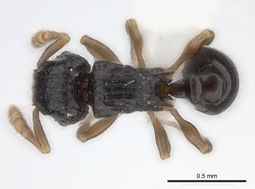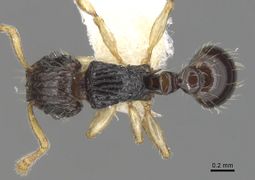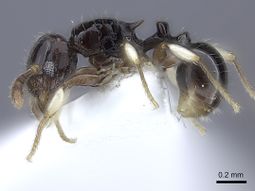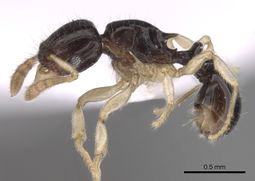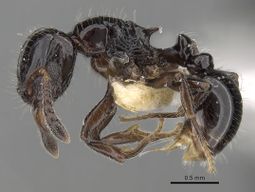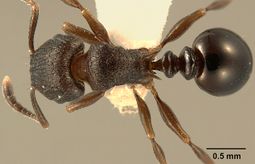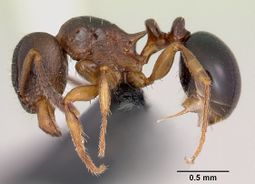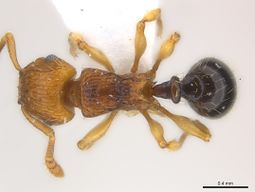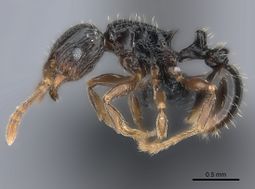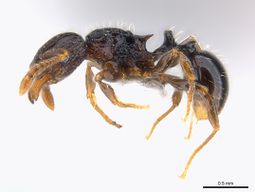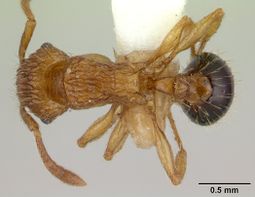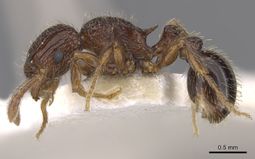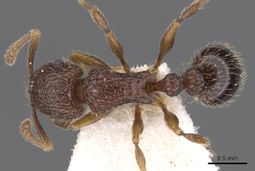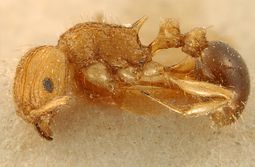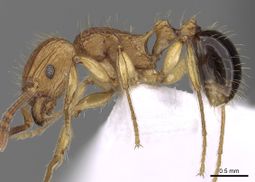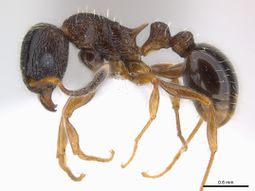Key to Afrotropical Tetramorium weitzeckeri-group species
You may also be interested in
The Tetramorium weitzeckeri-group species are primarily Afrotropical (one species occurs in both the Afrotropical and Malagasy regions). They were revised in Hita et al (2010)[1], and a new species was added in Hita & Fischer (2014)[2]
This key is the sum of both references, providing a key to all the species under the Tetramorium weitzeckeri group.
1
- Antennal scrobe well developed and usually deep, with distinct, and often sharp, margin all around, frontal carinae curve down ventrally between posterior eye level and posterior margin of head to form the posterior and ventral margins of the antennal scrobe (Fig. 2A), in few species posterior margin weak but visible; sculpturation on cephalic dorsum often reduced, generally 3 or fewer rugae present between frontal carinae, in few species up to 5 or 6, never more. (T. muralti complex) . . . . . 2
- Antennal scrobe developed, but shallow, never with a sharp margin all around, frontal carinae almost reach posterior margin of head and function as dorsal margin of antennal scrobe, ventral margin of antennal scrobe never differentiated (Fig. 2B); sculpturation on cephalic dorsum never reduced, always at least 7 (generally distinctly more) longitudinal rugae present between frontal carinae. (T. edouardi and T. weitzeckeri complexes) . . . . . 9
 FIGURE 2. A. head of Tetramorium flavithorax showing the well-developed antennal scrobe with distinct margin all around. B. head of Tetramorium mkomazi showing the weakly developed antennal scrobe without posterior and ventral margins. |
2
return to couplet #1
- Species with characteristic bicoloration: head, petiole, postpetiole, and gaster very dark brown to black, strongly contrasting with white to yellow mesosoma and appendages (Fig. 3A). (Ghana, Ivory Coast, Nigeria) . . . . . . Tetramorium flavithorax
- Head, mesosoma, and gaster uniformly coloured (Fig. 3B) . . . . . 3
 FIGURE 3. A. body of Tetramorium flavithorax in lateral view illustrating the characteristic bicoloration. B. uniformly coloured body of Tetramorium occidentale in profile. |
3
return to couplet #2
- Dorsum of mesosoma with 3 to 7 strong and unbroken longitudinal rugae (Fig. 4A) . . . . . 4
- Dorsum of mesosoma with reduced sculpture, at most with weak partial rugulation on pronotum or mesonotum, but generally completely smooth and shiny (Fig. 4B) . . . . . 5
 FIGURE 4. A. dorsum of mesosoma of Tetramorium trirugosum with 3 longitudinal rugae. B. mesosomal dorsum of Tetramorium susannae without any rugae or rugulae. |
4
return to couplet #3
- Antennal scape short (SI 65 - 70); petiolar node squamiform, strongly transverse and thin, in dorsal view between 2.5 to 3 times wider than long (DPeI 257 - 300); dorsum of mesosoma usually with 3, rarely 4, strong longitudinal rugae medially (Fig. 5A). (Cameroon, Gabon) . . . . . Tetramorium trirugosum
- Antennal scape of moderate size (SI 74 - 81); petiolar node thickly squamiform, in dorsal view either less than twice as wide as long or only faintly more (DPeI 179 - 211); dorsum of mesosoma with 6 or more longitudinal rugae (Fig. 5B). (Ghana) . . . . . Tetramorium intermedium
 FIGURE 5. A. dorsum of mesosoma of Tetramorium trirugosum with 3 longitudinal rugae. B. dorsum of mesosoma of Tetramorium intermedium with at least 6 longitudinal rugae. |
5
return to couplet #3
- Anterior clypeal margin always entire and convex (Fig. 6B) . . . . . 6
- Anterior clypeal margin with a distinct median impression of variable size (Fig. 6A) . . . . . 7
 FIGURE 6. A. anterior head of Tetramorium occidentale in dorsal view showing the impressed anterior clypeal margin. B. anterior head of Tetramorium susannae with entire and convex anterior clypeal margin. |
6
return to couplet #5
- Cephalic dorsum between frontal carinae with 3 longitudinal rugae, rugae between median ruga and frontal carinae often interrupted but always present (Fig. 7A); postpetiole rounded cuneiform, never with sharp dorsal transverse margin, in dorsal view never more than twice as wide as long (DPpI 173 -192). (Cameroon, Central African Republic, D.R. Congo, Gabon, Ghana, Ivory Coast) . . . . . Tetramorium muralti
- Cephalic dorsum with 1 unbroken median longitudinal ruga between frontal carinae, rarely traces of short rugulae present anteriorly near posterior clypeal margin or posteriorly near posterior margin of head (Fig. 7B); postpetiole strongly cuneiform with sharp dorsal transverse margin, in dorsal view distinctly more than twice as wide as long (DPpI 216 - 263). (Angola, Cameroon, Central African Republic, D.R. Congo, Gabon, Ghana) . . . . . Tetramorium susannae
 FIGURE 7. A. Cephalic dorsum of Tetramorium muralti with 3 longitudinal rugae between frontal carinae. B. cephalic dorsum of Tetramorium susannae with 1 median longitudinal ruga. |
7
return to couplet #5
- Metanotal groove impressed(Fig. 8A); postpetiole in lateral view strongly rounded dorsally and relatively low, only 1.25 times higher than long (LPpI 77 - 83), in dorsal view usually less than 1.5 times wider than long (DPpI 143 - 151) (Kenya) . . . . . Tetramorium kakamega
- Metanotal groove never impressed (Fig. 8B); postpetiole in lateral view not strongly rounded dorsally, usually cuneiform, between 1.3 to 1.6 times higher than long (LPeI 62 - 73), in dorsal view between 1.5 and 1.8 times wider than long (DPpI 153 - 182) . . . . . 8
 FIGURE 8. A. body of Tetramorium kakamega in profile showing the impressed metanotal groove and low postpetiole. B. body of Tetramorium occidentale without an impressed metanotal groove and with a distinctly higher postpetiole. |
8
return to couplet #7
- Petiolar node thickly squamiform, in dorsal view less than twice as wide as long (DPeI 188 - 196) (Fig. 9A); in lateral view weakly above twice as high as long (LPeI 47 - 50); colour uniformly reddish brown to brown. (D.R. Congo) . . . . . Tetramorium akengense
- Petiolar node moderately squamiform, in dorsal view distinctly above twice as wide as long (DPeI 225- 268) (Fig. 9B); in lateral view between 2.3 to 2.8 times higher than long (LPeI 36 - 44); colour uniformly very dark brown to black. (Cameroon, Central African Republic, Gabon, Ghana, São Tomé & Principe, Togo, Ivory Coast) . . . . . Tetramorium occidentale
 FIGURE 9. A. waist segments of Tetramorium akengense showing the relatively thick petiolar node. B. waist segments of Tetramorium occidentale illustrating the relatively thin and transverse petiolar node. |
9
return to couplet #1
- Petiolar node in profile distinctly squamiform (LPeI 25 - 43) (Fig. 10A), shape in dorsal view always elliptical, and usually distinctly much more than twice as wide as long (DPeI 219 - 367). (T. weitzeckeri complex) . . . . . 10
- Petiolar node in profile high nodiform (LPeI 50 - 80) (Fig. 10B), shape in dorsal view never elliptical, more an irregular polygon with rounded corners, and generally less than 1.5 times wider than long (DPeI 110 - 154). (T. edouardi complex) . . . . . 18
 FIGURE 10. A. waist segments of Tetramorium boltoni illustrating the squamiform petiolar node. B. waist segments of Tetramorium edouardi showing the high nodiform petiolar node. |
10
return to couplet #9
- First gastral tergite without standing hairs (Fig. 11A) . . . . . 11
- First gastral tergite with standing hairs (Fig. 11B) . . . . . 14a
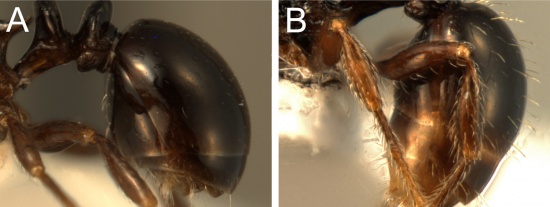 FIGURE 11. A. lateral view of gaster of Tetramorium bendai without any standing hairs on the first gastral tergite. B. lateral view of gaster of Tetramorium boltoni showing numerous standing hairs on the first gastral tergite. |
11
return to couplet #10
- Mesosoma with abundant long, erect hairs (usually 7 to 8 pairs of hairs) (Fig. 12A). (South Africa, Swaziland) . . . . . Tetramorium sepultum
- Mesosoma usually without long, erect hairs, in 1 species with up to 4 pairs of hairs at most (Fig. 12B) . . . . . 12
 FIGURE 12. A. mesosoma of Tetramorium sepultum in profile with at least 6 pairs of hairs on the dorsum. B. mesosoma of Tetramorium bendai in lateral view without any standing hairs on the dorsum. |
12
return to couplet #11
- Whole mesosoma with very distinct reticulate-punctate ground sculpturation underlaying a fine, mostly longitudinal rugulation (Fig. 13A). (Burundi) . . . . . Tetramorium bendai
- Mesosoma either mostly unsculptured or rugulose, but never with distinct reticulate-punctate ground sculpturation as above (Fig. 13B) . . . . . 13
 FIGURE 13. A. mesosomal dorsum of Tetramorium bendai with conspicuous reticulate-punctate ground sculpture and mostly longitudinal rugulation. B. mesosomal dorsum of Tetramorium tanaense with faint, smooth and shiny ground sculpturation and longitudinal rugulation. |
13
return to couplet #12
- Dorsum of mesosoma, especially of pronotum, unsculptured and shiny (Fig. 14A). (Madagascar, Comoros, Mauritius, Mayotte, Tanzania, Zambia, Zimbabwe, Namibia, South Africa) . . . . . Tetramorium humbloti
- Most of mesosomal dorsum longitudinally rugulose (Fig. 14B). (Kenya) . . . . . Tetramorium tanaense
 FIGURE 14. A. mesosoma of Tetramorium humbloti in dorsal view with unsculptured, smooth and shiny pronotum. B. mesosoma of Tetramorium tanaense with longitudinal rugulae from bases of propodeal spines to anterior pronotum in dorsal view. |
14a
return to couplet #10
- Eyes very large (OI 31); first gastral tergite with long, decumbent to subdecumbent (rarely appressed) pilosity [Kenya] (Fig. 6A, D) . . . . . Tetramorium mpala
- Eyes always smaller than above (OI 16–26); first gastral tergite with long suberect to erect pilosity (Fig. 6B–C, E–F) . . . . . 14b
14b
return to couplet #14a
- Dorsum of head with conspicuous reticulate-punctate ground sculpture; postpetiole in profile between 1.3 and 1.7 times higher than long (LPpI 59–75) and in dorsal view around 1.4 9 to 1.5 times wider than long (DPpI 137–154) (Fig. 7A, E–F) [Cameroon, Central African Republic, D.R. Congo, Gabon, Ghana, Guinea, Ivory Coast, Liberia, Nigeria] . . . . . Tetramorium guineense
- Character combination never as above; dorsum of head usually without conspicuous reticulate-punctate ground sculpture; if cephalic ground sculpture noticeably reticulate-punctate (as in some series of T. weitzeckeri), then postpetiole in profile around 1.7 to 2.1 times higher than long (LPpI 49–60) and in dorsal view 1.7 to 2.0 times wider than long (DPpI 146–203) (Fig. 7B–D, G–H) . . . . . 15
15
return to couplet #14b
- Distinctly bicoloured species, head and mesosoma orange to reddish brown, petiole, postpetiole and gaster very dark brown to black (Fig. 16A). (Central African Republic, Kenya, Uganda) . . . . . Tetramorium snellingi
- Whole body either uniformly brown to black or bicoloured with gaster, and often head, of lighter colour than mesosoma, petiole, and postpetiole (Fig. 16B) . . . . . 16
 FIGURE 16. A. body of Tetramorium snellingi in profile illustrating characteristic coloration. B. uniformly coloured body of Tetramorium boltoni in profile. |
16
return to couplet #15
- Species either bicoloured, with gaster, appendages and head yellowish brown contrasting with reddish brown mesosoma, petiole and postpetiole, or whole body dark brown to black; mesosomal sculpture partly reduced, dorsum generally with weak longitudinal rugulae only, lateral mesosoma to great extent unsculptured; ground sculpture on lateral and dorsal mesosoma absent, appearing smooth and shining (Figs 8C, 9A–B, E–F) [São Tomé & Principe] . . . . . Tetramorium renae
- Uniformly coloured species, generally dark brown to black; usually with mesosoma dorsally and laterally strongly longitudinally rugose, very rarely with weaker developed rugae or rugulae, in the latter case the ground sculpture is reticulate-punctate (Figs 8B, 9C–D, G–H) . . . . . 17
17
return to couplet #16
- Larger species (HW 0.77–0.93; HL 0.79–0.94; SL 0.60–0.74; WL 0.91–1.21); propodeal spines long to very long and spinose (PSLI 32–45); body colouration ranging from light brown to almost black, but usually of lighter brown than below; dry forest or savannah species (Figs 9G, 10A) [Angola, Eritrea, Kenya, Mozambique, Namibia, South Africa, Sudan, Swaziland, Tanzania, Zambia, Zimbabwe] . . . . . Tetramorium weitzeckeri
- Smaller species (HW 0.64–0.74; HL 0.68–0.76; SL 0.47–0.54; WL 0.78–0.91); propodeal spines moderate to long, triangular-elongate to spinose, but never as long as above (PSLI 23– 29); body colouration always very dark brown to black; rainforest species (Figs 9H, 10B) [Angola, Cameroon, Central African Republic, D.R. Congo, Equatorial Guinea, Gabon, Kenya, Nigeria, Uganda, Sudan] . . . . . Tetramorium boltoni
18
return to couplet #9
- Mesosoma, petiole, postpetiole, and first gastral tergite without standing hairs (Fig. 19A). (Tanzania) . . . . . Tetramorium mkomazi
- Mesosoma, petiole, postpetiole, and first gastral tergite with standing hairs, may be simple or bizarre but always present(Fig. 19B) . . . . . 19
 FIGURE 19. A. body of Tetramorium mkomazi in profile, mesosoma, petiole, postpetiole, and first gastral tergite without any standing hairs. B. body of Tetramorium philippwagneri in profile with standing hairs on dorsum of mesosoma, waist segments, and first gastral tergite. |
19
return to couplet #18
- Pilosity bizarre (pectinate, pinnate, clavate, or broad, flattened, and appressed) (Fig. 20A) . . . . . 20
- Pilosity simple, never bizarrely modified as above (Fig. 20B) . . . . . 22
 FIGURE 20. A. body of Tetramorium pinnipilum in profile with bizarrely modified pilosity. B. body of Tetramorium philippwagneri in profile with simple pilosity. |
20
return to couplet #19
- Pilosity broad, flattened, and appressed, especially on first gastral tergite (Fig. 21A). (Cameroon, D.R. Congo, Kenya, Rwanda, Sudan, Tanzania, Uganda) . . . . . Tetramorium zonacaciae
- Pilosity pectinate, pinnate, or clavate, but never broad, flattened and appressed (Fig. 21B) . . . . . 21
 FIGURE 21. A. body of Tetramorium zonacaciae in lateral view showing broad, flattened, and appressed pilosity. B. body of Tetramorium pinnipilum in lateral view showing pectinate, pinnate pilosity. |
21
return to couplet #20
- Pilosity pectinate, pinnate. (Angola, Kenya) . . . . . Tetramorium pinnipilum
- Pilosity clavate, especially on first gastral tergite. (Angola) . . . . . Tetramorium rogatum
22
return to couplet #19
- Eyes relatively small (OI 21 - 22), bicoloured species, gaster significantly much darker than remaining body (Fig. 22A) . . . . . 23
- Eyes relatively large (OI 23 - 30), uniformly coloured species (Fig. 22B) . . . . . 24
 FIGURE 22. A. body of Tetramorium philippwagneri in profile illustrating the characteristic coloration and relatively small eyes. B. body of Tetramorium rubrum in profile showing the uniform coloration and relatively larger eyes. |
23
return to couplet #22
- Mandibles unsculptured, smooth and shiny. (D.R. Congo) . . . . . Tetramorium schoutedeni
- Mandibles with longitudinal striation, sometimes fine but always present. (Cameroon, Gabon, Zambia) . . . . . Tetramorium philippwagneri
24
return to couplet #22
- Median area of clypeus unsculptured, smooth and shiny (Fig. 23A). (Tanzania) . . . . . Tetramorium robertsoni
- Clypeus with distinct median longitudinal ruga and 1 or 2 additional lateral rugae on each side (Fig. 23B) . . . . . 25
 FIGURE 23. A. anterior head of Tetramorium robertsoni in dorsal view with unsculptured median area of clypeus. B. anterior head of Tetramorium rubrum in dorsal view showing the typical longitudinal rugae. |
25
return to couplet #24
- Antennal scapes larger (SI 85 - 92); eyes smaller (OI 23 - 26); head relatively longer (CI 87 - 91) (Fig. 24A); in profile metanotal groove not impressed; coloration reddish brown. (Cameroon, Ghana, Nigeria) . . . . . Tetramorium rubrum
- Antennal scapes shorter (SI 76 - 83); eyes larger (OI 26 - 30); head relatively shorter (CI 90 - 95) (Fig. 24B); in profile metanotal groove distinctly impressed; usually of very dark brown to nearly black colour. (Burundi, D.R. Congo, Ethiopia, Kenya, Tanzania, Uganda) . . . . . Tetramorium edouardi
 FIGURE 24. A. head of Tetramorium rubrum in full-face view with smaller eyes, longer head and antennal scapes. B. head of Tetramorium edouardi in full-face view with larger eyes, shorter head and antennal scapes. |
References
- ↑ Hita Garcia, F.; Fischer, G.; Peters, M. K. 2010b. Taxonomy of the Tetramorium weitzeckeri species group (Hymenoptera: Formicidae) in the Afrotropical zoogeographical region. Zootaxa 2704:1-90. [2010-12-03]
- ↑ Hita Garcia, F. & Fischer, G. 2014. Additions to the taxonomy of the Afrotropical Tetramorium weitzeckeri species complex (Hymenoptera, Formicidae, Myrmicinae), with the description of a new species from Kenya. European Journal of Taxonomy 90: 1–16.





